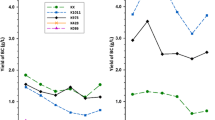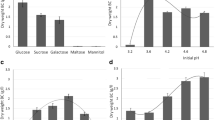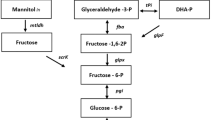Abstract
This study is focused on the characterization of bacterial cellulose (BC) produced by Komagataeibacter xylinus strains DSM 2325, DSM 2004, and DSM 46604 from styrene/glucose mixtures. Styrene, the aromatic monomer of petrochemical plastics such as polystyrene, served as a co-substrate for bacterial cultivation, being assimilated by all strains, although with differing efficiency for BC biosynthesis. The best performing strain was K. xylinus DSM 2325 with a BC production of 2.70 ± 0.4 g/L. Interestingly, K. xylinus DSM 2004 produced BC from styrene as the sole carbon source, yielding 0.32 ± 0.02 g/L BC. The presence of styrene in the cultivation media had a minor influence on the produced BC chemical structure, thermal degradation temperature (318–337 °C), and morphology, where compact fibers of diameters ranging from 31 to 47 nm were observed. The crystallinity index of the samples was obtained through X-ray diffraction and showed that values varied according to the medium used (41–33%). However, the membranes synthesized in the presence of styrene were thinner (3–22 μm) than those produced from glucose (12–44 μm) and had low gas permeability. K. xylinus DSM 2325 and DSM 2004 membranes had also low permeability for O2 (1.1–2.5 barrer) and CO2 (2.5–5.8 barrer), while those produced by K. xylinus DSM 46604 had a higher permeability to CO2 (42.3 barrer) together with low permeability to O2 (2.5 barrer). Moreover, BC produced by K. xylinus DSM 2325 with styrene as an additive showed the highest crystallinity among all strains and mediums (46%). These results show the feasibility of using styrene as an effective co-substrate in a sustainable approach for its valorisation into a value-added biopolymer, with the advantage of tuning BC properties according to the envisaged application, by selecting the appropriate producing strain and culture medium.




Similar content being viewed by others
Availability of data and materials
Data and materials will be provided on request.
References
Akintunde MO, Adebayo-Tayo BC, Ishola MM et al (2022) Bacterial cellulose production from agricultural residues by two Komagataeibacter sp. Strains Bioengineered 13:10010–10025. https://doi.org/10.1080/21655979.2022.2062970
Aliabadi M, Aroujalian A, Raisi A (2012) Removal of styrene from petrochemical wastewater using pervaporation process. Desalination 284:116–121. https://doi.org/10.1016/j.desal.2011.08.044
Alonso-Campos V, Covarrubias-García I, Arriaga S (2022) Styrene bioconversion by Pseudomonas putida utilizing a non-aqueous phase for polyhydroxyalkanoate production. J Chem Technol Biotechnol 97:1424–1435. https://doi.org/10.1002/jctb.6935
Andriani D, Apriyana AY, Karina M (2020) The optimization of bacterial cellulose production and its applications: a review. Cellulose 27:6747–6766. https://doi.org/10.1007/s10570-020-03273-9
Andritsou V, De Melo EM, Tsouko E et al (2018) Synthesis and characterization of bacterial cellulose from citrus-based sustainable resources. ACS Omega 3:10365–10373. https://doi.org/10.1021/acsomega.8b01315
Aswini K, Gopal NO, Uthandi S (2020) Optimized culture conditions for bacterial cellulose production by Acetobacter senegalensis MA1. BMC Biotechnol 20:1–16. https://doi.org/10.1186/s12896-020-00639-6
Bao L, Dorgan JR, Knauss D et al (2006) Gas permeation properties of poly(lactic acid) revisited. J Memb Sci 285:166–172. https://doi.org/10.1016/j.memsci.2006.08.021
Buldum G, Bismarck A, Mantalaris A (2018) Recombinant biosynthesis of bacterial cellulose in genetically modified Escherichia coli. Bioprocess Biosyst Eng 41:265–279. https://doi.org/10.1007/s00449-017-1864-1
Cacicedo ML, Castro MC, Servetas I et al (2016) Progress in bacterial cellulose matrices for biotechnological applications. Bioresour Technol 213:172–180. https://doi.org/10.1016/j.biortech.2016.02.071
Cavka A, Guo X, Tang SJ et al (2013) Production of bacterial cellulose and enzyme from waste fiber sludge. Biotechnol Biofuels 6:1–10. https://doi.org/10.1186/1754-6834-6-25
Cazón P, Vázquez M, Velazquez G (2019) Composite films with UV-barrier properties based on bacterial cellulose combined with chitosan and Poly(vinyl alcohol): study of puncture and water interaction properties. Biomacromol 20(5):2084–2095
Chen W, Yu H, Lee SY et al (2018) Nanocellulose: A promising nanomaterial for advanced electrochemical energy storage. Chem Soc Rev 47:2837–2872. https://doi.org/10.1039/c7cs00790f
Choi SM, Shin EJ (2020) The nanofication and functionalization of bacterial cellulose and its applications. Nanomaterials 10:1–24. https://doi.org/10.3390/nano10030406
Choi YJ, Ahn Y, Kang MS et al (2004) Preparation and characterization of acrylic acid-treated bacterial cellulose cation-exchange membrane. J Chem Technol Biotechnol 79:79–84. https://doi.org/10.1002/jctb.942
Costa AFS, Almeida FCG, Vinhas GM, Sarubbo LA (2017) Production of bacterial cellulose by Gluconacetobacter hansenii using corn steep liquor as nutrient sources. Front Microbiol 8:2027. https://doi.org/10.3389/fmicb.2017.02027
Ebciba C, Pavithra N, Chris Felshia F, Gnanamani A (2020) Exploring the styrene metabolism by aerobic bacterial isolates for the effective management of leachates in an aqueous system. RSC Adv 10:26535–26545. https://doi.org/10.1039/d0ra03822a
Esmail A, Rebocho AT, Marques AC et al (2022) Bioconversion of terephthalic acid and ethylene glycol into bacterial cellulose by Komagataeibacter xylinus DSM 2004 and DSM 46604. Front Bioeng Biotechnol 10:1–11. https://doi.org/10.3389/fbioe.2022.853322
Eusébio TM, Martins AR, Pon G et al (2020) Sorption/diffusion contributions to the gas permeation properties of bi-soft segment polyurethane/polycaprolactone membranes for membrane blood oxygenators. Membranes (basel). https://doi.org/10.3390/membranes10010008
Gayathri G, Srinikethan G (2019) Bacterial cellulose production by K. saccharivorans BC1 strain using crude distillery effluent as cheap and cost effective nutrient medium. Int J Biol Macromol 138:950–957. https://doi.org/10.1016/j.ijbiomac.2019.07.159
Gea S, Reynolds CT, Roohpour N et al (2011) Investigation into the structural, morphological, mechanical and thermal behaviour of bacterial cellulose after a two-step purification process. Bioresour Technol 102:9105–9110. https://doi.org/10.1016/j.biortech.2011.04.077
Gorgieva S, Trček J (2019) Bacterial cellulose: production, modification and perspectives in biomedical applications. Nanomaterials 9:1–20. https://doi.org/10.3390/nano9101352
Ha JH, Shah N, Ul-Islam M et al (2011) Bacterial cellulose production from a single sugar α-linked glucuronic acid-based oligosaccharide. Process Biochem 46:1717–1723. https://doi.org/10.1016/j.procbio.2011.05.024
Hestrin S, Schramm M (1954) Synthesis of cellulose by Acetobacter xylinum. II. Biochem J, Preparation of freeze-dried cells capable of polymerizing glucose to cellulose. https://doi.org/10.1042/bj0580345
Hong F, Zhu YX, Yang G, Yang XX (2011) Wheat straw acid hydrolysate as a potential cost-effective feedstock for production of bacterial cellulose. J Chem Technol Biotechnol 86:675–680. https://doi.org/10.1002/jctb.2567
Hwang J, Choi D, Han S et al (2020) Potential toxicity of polystyrene microplastic particles. Sci Rep 10:1–12. https://doi.org/10.1038/s41598-020-64464-9
Janeni J, Adassooriya NM (2021) Nanocellulose biopolymer-based biofilms: applications and challenges. In: Biopolymer-based nano films: applications in food packaging and wound healing. pp 43–62
Jia Y, Wang X, Huo M et al (2017) Preparation and characterization of a novel bacterial cellulose/chitosan bio-hydrogel. Nanomater Nanotechnol 7:1–8. https://doi.org/10.1177/1847980417707172
Kadier A, Ilyas RA, Huzaifah MRM et al (2021) Use of industrial wastes as sustainable nutrient sources for bacterial cellulose (BC) production: mechanism, advances, and future perspectives. Polymers (basel). https://doi.org/10.3390/polym13193365
Kim H, Son J, Lee J et al (2021) Improved production of bacterial cellulose through investigation of effects of inhibitory compounds from lignocellulosic hydrolysates. GCB Bioenergy 13:436–444. https://doi.org/10.1111/gcbb.12800
Lee KY, Quero F, Blaker JJ et al (2011) Surface only modification of bacterial cellulose nanofibres with organic acids. Cellulose 18:595–605. https://doi.org/10.1007/s10570-011-9525-z
Lee YJ, An SJ, Bin BE et al (2017) The effect of thickness of resorbable bacterial cellulose membrane on guided bone regeneration. Materials (basel). https://doi.org/10.3390/ma10030320
Li Z, Wang L, Hua J et al (2015) Production of nano bacterial cellulose from waste water of candied jujube-processing industry using Acetobacter xylinum. Carbohydr Polym 120:115–119. https://doi.org/10.1016/j.carbpol.2014.11.061
Lide D (2008) CRC handbook of chemistry and physics online
Lu Z, Zhang Y, Chi Y et al (2011) Effects of alcohols on bacterial cellulose production by Acetobacter xylinum 186. World J Microbiol Biotechnol 27:2281–2285. https://doi.org/10.1007/s11274-011-0692-8
Marín P, Martirani-Von Abercron SM, Urbina L et al (2019) Bacterial nanocellulose production from naphthalene. Microb Biotechnol 12:662–676. https://doi.org/10.1111/1751-7915.13399
Michiels Y, Van Puyvelde P, Sels B (2017) Barriers and chemistry in a bottle: mechanisms in today’s oxygen barriers for tomorrow’s materials. Appl Sci. https://doi.org/10.3390/app7070665
Mishra S, Singh PK, Pattnaik R et al (2022) Biochemistry, synthesis, and applications of bacterial cellulose: a review. Front Bioeng Biotechnol 10:1–12. https://doi.org/10.3389/fbioe.2022.780409
Moosavi-Nasab M, Yousefi A (2011) Biotechnological production of cellulose by Gluconacetobacter xylinus from agricultural waste. Iran J Biotechnol 9:94–101
Movasaghi Z, Rehman S, ur Rehman DI (2008) Fourier transform infrared (FTIR) spectroscopy of biological tissues. Appl Spectrosc Rev 43:134–179. https://doi.org/10.1080/0570492070182904
Mustarichie R, Tahid T, Ramdhani D (2018) Comparison of residual styrene monomer determination of pharmaceutical materials packed with polystyrene using gas chromatography and ultraviolet/visible spectrophotometer. Natl J Physiol Pharm Pharmacol 8:1. https://doi.org/10.5455/njppp.2018.8.0207501032018
Naomi R, Idrus RBH, Fauzi MB (2020) Plant-vs. Bacterial-derived cellulose for wound healing: A review. Int J Environ Res Public Health 17:1–25. https://doi.org/10.3390/ijerph17186803
Nascimento FX, Torres CAV, Freitas F et al (2021) Functional and genomic characterization of Komagataeibacter uvaceti FXV3, a multiple stress resistant bacterium producing increased levels of cellulose. Biotechnol Reports 30:e00606. https://doi.org/10.1016/j.btre.2021.e00606
Neves LA, Crespo JG, Coelhoso IM (2010) Gas permeation studies in supported ionic liquid membranes. J Memb Sci 357:160–170. https://doi.org/10.1016/j.memsci.2010.04.016
Ogrizek L, Lamovšek J, Čuš F et al (2021) Properties of bacterial cellulose produced using white and red grape bagasse as a nutrient source. Processes. https://doi.org/10.3390/pr9071088
Oh SY, Dong IY, Shin Y et al (2005) Crystalline structure analysis of cellulose treated with sodium hydroxide and carbon dioxide by means of X-ray diffraction and FTIR spectroscopy. Carbohydr Res 340:2376–2391. https://doi.org/10.1016/j.carres.2005.08.007
Pang M, Huang Y, Meng F et al (2020) Application of bacterial cellulose in skin and bone tissue engineering. Eur Polym J 122:109365. https://doi.org/10.1016/j.eurpolymj.2019.109365
Park JK, Jung JY, Park YH (2003) Cellulose production by Gluconacetobacter hansenii in a medium containing ethanol. Biotechnol Lett 25:2055–2059. https://doi.org/10.1023/B:BILE.0000007065.63682.18
Park S, Baker JO, Himmel ME et al (2010) Cellulose crystallinity index: measurement techniques and their impact on interpreting cellulase performance. Biotechnol Biofuels 3:1–10. https://doi.org/10.1186/1754-6834-3-10
Patti A, Acierno D (2020) The puncture and water resistance of polyurethane-impregnated fabrics after UV weathering. Polymers (basel) 12:1–14. https://doi.org/10.3390/polym12010015
Paunonen S (2013) Strength and barrier enhancements of cellophane and cellulose derivative films: a review. BioResources 8:3098–3121. https://doi.org/10.15376/biores.8.2.3098-3121
Peres MFS, Nigoghossian K, Primo FL et al (2016) Bacterial cellulose membranes as a potential drug delivery system for photodynamic therapy of skin cancer. J Braz Chem Soc 27:1949–1959. https://doi.org/10.5935/0103-5053.20160080
Portela R, Leal CR, Almeida PL, Sobral RG (2019) Bacterial cellulose: a versatile biopolymer for wound dressing applications. Microb Biotechnol 12:586–610. https://doi.org/10.1111/1751-7915.13392
Pourramezan GZ, Roayaei AM, Qezelbash QR (2009) Optimization of culture conditions for bacterial cellulose production by Acetobacter sp. 4B–2. Biotechnology 8:150–154. https://doi.org/10.3923/biotech.2009.150.154
Rebelo AR, Archer AJ, Chen X et al (2018) Dehydration of bacterial cellulose and the water content effects on its viscoelastic and electrochemical properties. Sci Technol Adv Mater 19:203–211. https://doi.org/10.1080/14686996.2018.1430981
Rebocho AT, Pereira JR, Freitas F et al (2019) Production of medium-chain length polyhydroxyalkanoates by Pseudomonas citronellolis grown in apple pulp waste. Appl Food Biotechnol 6:71–82. https://doi.org/10.22037/afb.v6i1.21793
Revin V, Liyaskina E, Nazarkina M et al (2018) Cost-effective production of bacterial cellulose using acidic food industry by-products. Br J Microbiol 49:151–159. https://doi.org/10.1016/j.bjm.2017.12.012
Riaz U, Ashraf SM (2015) Characterization of polymer blends with FTIR spectroscopy. In: Characterization of polymer blends: miscibility, morphology and interfaces. pp 625–678
Roy N, Saha N, Humpolicek P, Saha P (2010) Permeability and biocompatibility of novel medicated hydrogel wound dressings. Soft Mater 8:338–357. https://doi.org/10.1080/1539445X.2010.502955
Semsarzadeh MA, Sadcghi M, Barikani M (2008) Effect of chain extender length on gas permeation properties of polyurethane membranes. Iran Polym J (english Ed) 17:431–440
Singhsa P, Narain R, Manuspiya H (2018) Physical structure variations of bacterial cellulose produced by different Komagataeibacter xylinus strains and carbon sources in static and agitated conditions. Cellulose 25:1571–1581. https://doi.org/10.1007/s10570-018-1699-1
Szymańska-Chargot M, Cybulska J, Zdunek A (2011) Sensing the structural differences in cellulose from apple and bacterial cell wall materials by Raman and FT-IR spectroscopy. Sensors 11:5543–5560. https://doi.org/10.3390/s110605543
Tan GYA, Chen CL, Ge L et al (2015) Bioconversion of styrene to poly(hydroxyalkanoate) (PHA) by the new bacterial strain Pseudomonas putida NBUS12. Microbes Environ 30:76–85. https://doi.org/10.1264/jsme2.ME14138
Thongwai N, Futui W, Ladpala N et al (2022) Characterization of bacterial cellulose produced by Komagataeibacter maltaceti P285 isolated from contaminated honey wine. Microorganisms 10:528. https://doi.org/10.3390/microorganisms10030528
Tomé LC, Brandão L, Mendes AM et al (2010) Preparation and characterization of bacterial cellulose membranes with tailored surface and barrier properties. Cellulose 17:1203–1211. https://doi.org/10.1007/s10570-010-9457-z
Torgbo S, Sukyai P (2020) Biodegradation and thermal stability of bacterial cellulose as biomaterial: the relevance in biomedical applications. Polym Degrad Stab 179:109232. https://doi.org/10.1016/j.polymdegradstab.2020.109232
Tran NPD, Ting CC, Lin CH, Yang MC (2020) A novel approach to increase the oxygen permeability of soft contact lenses by incorporating silica sol. Polymers (basel). https://doi.org/10.3390/POLYM12092087
Vázquez M, Velazquez G, Cazón P (2021) UV-shielding films of bacterial cellulose with glycerol and chitosan. Part 1: equilibrium moisture content and mechanical properties. CYTA J Food 19:105–114. https://doi.org/10.1080/19476337.2020.1870566
Wada M, Okano T (2001) Localization of Iα and Iβ phases in algal cellulose revealed by acid treatments. Cellulose 8:183–188. https://doi.org/10.1023/A:1013196220602
Yang Y, Ponting M, Thompson G et al (2012) Puncture deformation and fracture mechanism of oriented polymers. J Appl Polym Sci 124:2524–2536. https://doi.org/10.1002/app.34109
Yang XY, Huang C, Guo HJ et al (2016) Bacterial cellulose production from the litchi extract by Gluconacetobacter xylinus. Prep Biochem Biotechnol 46:39–43. https://doi.org/10.1080/10826068.2014.958163
Yeh V, Goode A, Johnson D et al (2022) The role of lipid chains as determinants of membrane stability in the presence of styrene. Langmuir 38:1348–1359. https://doi.org/10.1021/acs.langmuir.1c02332
Zhang Y, Chen Y, Cao G et al (2021) Bacterial cellulose production from terylene ammonia hydrolysate by Taonella mepensis WT-6. Int J Biol Macromol 166:251–258. https://doi.org/10.1016/j.ijbiomac.2020.10.172
Zhong C (2020) Industrial-scale production and applications of bacterial cellulose. Front Bioeng Biotechnol 8:1425. https://doi.org/10.3389/fbioe.2020.605374
Acknowledgments
The authors acknowledge the National Natural Science Foundation of China (Grant Numbers: Institute of Microbiology, Chinese Academy of Sciences: 31961133016; Beijing Institute of Technology: 31961133015; Shandong University: 31961133014) for support of the Project Bio Innovation of a Circular Economy for Plastics (BioICEP).
Funding
This work was financed by national funds from FCT/MCTES—Fundação para a Ciência e a Tecnologia, I.P., Ministério da Ciência, Tecnologia e Ensino Superior, in the scope of the projects UIDP/04378/2020 and UIDB/04378/2020 of the Research Unit on Applied Molecular Biosciences—UCIBIO, project LA/P/0140/202019 of the Associate Laboratory Institute for Health and Bioeconomy—i4HB, projects UIDB/50006/2020 and UIDP/50006/2020 of the Associate Laboratory for Green Chemistry—LAQV, and projects LA/P/0037/2020, UIDP/50025/2020 and UIDB/50025/2020 of the Associate Laboratory Institute of Nanostructures, Nanomodelling and Nanofabrication—i3N, and by the European Union’s Horizon 2020 research and innovation programme through Project Bio Innovation of a Circular Economy for Plastics (BioICEP), under grant agreement No 870292. Asiyah Esmail and Paloma Ortiz-Albo acknowledge FCT I.P. for PhD Grants 2021.05014.BD and SFRH/BD/139389/2018, respectively.
Author information
Authors and Affiliations
Contributions
Conceptualization: AE, CAVT and FF; Methodology: AE, POA, ACM, JVP and AG; Formal analysis and investigation: AE, JVP and LAN; Writing—original draft preparation: AE; Writing—review and editing: CAVT, LAN, MAMR and FF; Funding acquisition: MAMR and FF; Resources: LAN, MAMR and FF; Supervision: CAVT and FF.
Corresponding author
Ethics declarations
Conflict of interests
The authors declare no competing interests.
Ethics approval
Not applicable.
Consent to participate
Not applicable.
Consent for publication
Not applicable.
Additional information
Publisher's Note
Springer Nature remains neutral with regard to jurisdictional claims in published maps and institutional affiliations.
Supplementary Information
Below is the link to the electronic supplementary material.
Rights and permissions
Springer Nature or its licensor (e.g. a society or other partner) holds exclusive rights to this article under a publishing agreement with the author(s) or other rightsholder(s); author self-archiving of the accepted manuscript version of this article is solely governed by the terms of such publishing agreement and applicable law.
About this article
Cite this article
Esmail, A., Torres, C.A.V., Ortiz-Albo, P. et al. Characterization of bacterial cellulose produced by Komagataeibacter xylinus strains grown in styrene/glucose mixtures. Cellulose 30, 10811–10824 (2023). https://doi.org/10.1007/s10570-023-05559-0
Received:
Accepted:
Published:
Issue Date:
DOI: https://doi.org/10.1007/s10570-023-05559-0




